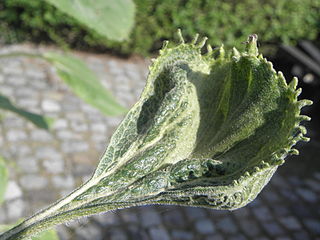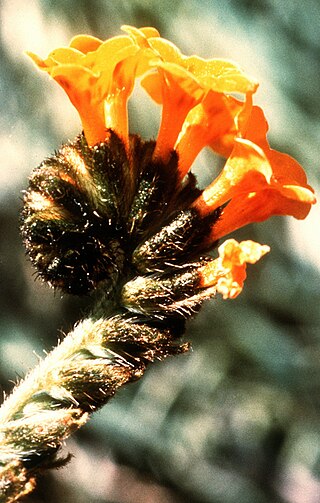Related Research Articles

Herbicides, also commonly known as weed killers, are substances used to control undesired plants, also known as weeds. Selective herbicides control specific weed species while leaving the desired crop relatively unharmed, while non-selective herbicides kill plants indiscriminately. The combined effects of herbicides, nitrogen fertilizer, and improved cultivars has increased yields of major crops by three to six times from 1900 to 2000.

Biological control or biocontrol is a method of controlling pests, whether pest animals such as insects and mites, weeds, or pathogens affecting animals or plants by using other organisms. It relies on predation, parasitism, herbivory, or other natural mechanisms, but typically also involves an active human management role. It can be an important component of integrated pest management (IPM) programs.

Weed control is a type of pest control, which attempts to stop or reduce growth of weeds, especially noxious weeds, with the aim of reducing their competition with desired flora and fauna including domesticated plants and livestock, and in natural settings preventing non native species competing with native species.
Integrated pest management (IPM), also known as integrated pest control (IPC) that integrates both chemical and non-chemical practices for economic control of pests. The UN's Food and Agriculture Organization defines IPM as "the careful consideration of all available pest control techniques and subsequent integration of appropriate measures that discourage the development of pest populations and keep pesticides and other interventions to levels that are economically justified and reduce or minimize risks to human health and the environment. IPM emphasizes the growth of a healthy crop with the least possible disruption to agro-ecosystems and encourages natural pest control mechanisms." Entomologists and ecologists have urged the adoption of IPM pest control since the 1970s. IPM is a safer pest control framework than reliance on the use of chemical pesticides, mitigating risks such as: insecticide-induced resurgence, pesticide resistance and (especially food) crop residues.

Xanthium (cocklebur) is a genus of flowering plants in the tribe Heliantheae within the family Asteraceae, native to the Americas and eastern Asia and some parts of south Asia.
A Biopesticide is a biological substance or organism that damages, kills, or repels organisms seens as pests. Biological pest management intervention involves predatory, parasitic, or chemical relationships.
The need for a clearly defined and consistent invasion biology terminology has been acknowledged by many sources. Invasive species, or invasive exotics, is a nomenclature term and categorization phrase used for flora and fauna, and for specific restoration-preservation processes in native habitats. Invasion biology is the study of these organisms and the processes of species invasion.

A bur is a seed or dry fruit or infructescence that has hooks or teeth. The main function of the bur is to spread the seeds of the bur plant, often through epizoochory. The hooks of the bur are used to latch onto fur or fabric, enabling the bur – which contain seeds – to be transported to another location for dispersal. Another use for the spines and hooks are physical protection against herbivores. Their ability to stick to animals and fabrics has shaped their reputation as bothersome.

Xanthium strumarium is a species of annual plants of the family Asteraceae. Some sources claim it originates in southern Europe and Asia, but has been extensively naturalized elsewhere. Others, such as the Flora of China and Flora of North America, state it originates in the Americas but was an early introduction to Eurasia.

Plasmopara halstedii is a plant pathogen infecting sunflowers. The species is one of many pathogens commonly referred to as downy mildew. P. halstedii originated in North America.

Amsinckia grandiflora is a species of fiddleneck known by the common name large-flowered fiddleneck. This is a wildflower endemic to California and considered a Critically endangered species on the state and national level. Amsinckia grandiflora is one of four 1248 rare heterostylous species within the genus Amsinckia that have highly restricted distributions from which the more weedy homostylous congeners are thought to have evolved.
Aphthona abdominalis is a species of leaf beetle known as the minute spurge flea beetle. It was used as an agent of biological pest control against the noxious weed leafy spurge, but never established a viable population.
Bangasternus orientalis is a species of true weevil known as the yellow starthistle bud weevil. It is used as an agent of biological pest control against the noxious weed yellow starthistle.

A weed is a plant considered undesirable in a particular situation, growing where it conflicts with human preferences, needs, or goals. Plants with characteristics that make them hazardous, aesthetically unappealing, difficult to control in managed environments, or otherwise unwanted in farm land, orchards, gardens, lawns, parks, recreational spaces, residential and industrial areas, may all be considered weeds. The concept of weeds is particularly significant in agriculture, where the presence of weeds in fields used to grow crops may cause major losses in yields. Invasive species, plants introduced to an environment where their presence negatively impacts the overall functioning and biodiversity of the ecosystem, may also sometimes be considered weeds.

Gorse was introduced to New Zealand in the early stages of European settlement. It is now a major invasive plant species with millions of dollars spent on its control.

Euaresta aequalis is a species of fruit fly in the genus Euaresta of the family Tephritidae.

Mesotrione is a selective herbicide used mainly in maize crops. It is a synthetic compound inspired by the natural substance leptospermone found in the bottlebrush tree Callistemon citrinus. It inhibits the enzyme 4-hydroxyphenylpyruvate dioxygenase (HPPD) and is sold under brand names including Callisto and Tenacity. It was first marketed by Syngenta in 2001.

In Australia, Mimosa pigra has been declared a noxious weed or given similar status under various weed or quarantine Acts. It has been ranked as the tenth most problematic weed and is listed on the Weeds of National Significance. It is currently restricted to the Northern Territory where it infests approximately 80,000 hectares of coastal floodplain.

Centaurea stoebe, the spotted knapweed or panicled knapweed, is a species of Centaurea native to eastern Europe, although it has spread to North America, where it is considered an invasive species. It forms a tumbleweed, helping to increase the species' reach, and the seeds are also enabled by a feathery pappus.

Euphorbia virgata, commonly known as leafy spurge, wolf's milk leafy spurge, or wolf's milk is a species of spurge native to Europe and Asia, and introduced in North America, where it is an invasive species.
References
- ↑ Center, T.D.; Van, T.K.; Hill, M.P. (2001), "Can Competition Experiments Be Used to Evaluate the Potential Efficacy of New Water Hyacinth Biological Control Agents?", in Julien, M.H.; Hill, M.P.; Center, T.D.; et al. (eds.), ACIAR Proceedings No. 102, Biological and Integrated Control of Water Hyacinth, Eichornia crassipes, Beijing, China, pp. 77–81
{{citation}}: CS1 maint: location missing publisher (link) - ↑ Parker, P.E. (1991), "Nematodes as biological control agents of weeds", in TeBeest, D.O. (ed.), Microbial Control of Weeds, Chapman Hall, New York, pp. 58–68
- ↑ Ng, H.Y.F.; Gaynor, J.D.; Drury, C.F. (1995), "Dissipation and loss of atrazine and metolachlor in surface and subsurface drain water: A case study", Water Research, 29 (10): 2309–2317, Bibcode:1995WatRe..29.2309N, doi:10.1016/0043-1354(95)00071-R
- ↑ Adelman, D.D.; Van, T.K.; Hill, M.P. (2000), "Evaluation of the Pesticide Runoff Component of AGNPS, Section 57, Chapter 1", in Hotchkiss, R.H.; Glade, M. (eds.), 2000 Joint Conference on Water Resources Engineering and Water Resources Planning & Management, Minneapolis, Minnesota, p. 204
{{citation}}: CS1 maint: location missing publisher (link) - ↑ Abbas, H.K.; Pantone, D.J.; Paul, R.N. (1999), "Characteristics of multiple-seeded cocklebur: A biotype of common cocklebur (Xanthium strumarium L.)", Weed Technology, 13 (2): 257–263, doi:10.1017/S0890037X00041701, S2CID 89182777
- ↑ Abbas, H.K.; Johnson, B.J.; Pantone, D.J.; Wax, L.; Hines, R.; Shier, W.T. (2005), "Chemical control of multiple seeded cocklebur (Xanthium strumarium L.) in comparison with several other cocklebur types", Pest Management Science, 61 (7): 643–648, doi:10.1002/ps.1033, PMID 15712354
- ↑ Pavlik, B.M.; Nickrent, A.M.; Howald, D.J. (1993), "The Recovery of an Endangered Plant. I. Creating a New Population of Amsinckia grandiflora", Conservation Biology, 7 (3): 510–526, Bibcode:1993ConBi...7..510P, doi:10.1046/j.1523-1739.1993.07030510.x
- ↑ Carlsen, T.M. (1996), "Population and Community Ecology of the Rare Plant Amsinckia grandiflora", Ph.D. Dissertation, University of California, Davis: 8–43
- ↑ Gibson, A.C.; Sharifi, M.R.; Rundel, P.W. (1998), "Ecophysiological observations on Lane Mountain Milkvetch, Astragalus jaegerianus (Fabaceae), a proposed endangered species of the Mojave Desert", Aliso, 17: 77–82, doi: 10.5642/aliso.19981701.07